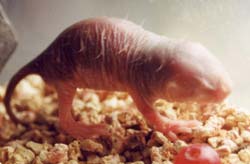Naked mole-rats bare pain relief clues

Credit: Thomas Park of UIC
East African naked mole-rats, the only known cold-blooded mammal, have shown a rather heated response in lab tests that may have important implications for treating chronic pain in humans.
The blind, furless creatures that live underground in colonies lack a body chemical called Substance P, a neurotransmitter normally in the skin that sends pain signals to the central nervous system. The rats feel no immediate pain when cut, scraped or subjected to heat stimuli. They only feel some aches. But when the rats get a shot of Substance P, pain signaling resumes working as in other mammals.
“It was a complete surprise when we discovered that the skin of naked mole-rats is missing one of the most basic chemicals that’s found in the skin of all other mammals,” said Thomas Park, associate professor of biological sciences at the University of Illinois at Chicago and the principal investigator in the research project.
Co-investigators include Christopher Comer, professor of biological sciences, Ying Lu, assistant professor of anesthesiology and Charles Laurito, professor of anesthesiology — all at UIC — along with pharmacologists Frank Rice of the Albany Medical College in Albany, N.Y. and Steven Wilson, of the University of South Carolina School of Medicine.
The findings were reported in a presentation by Lu Nov.8 in New Orleans at the annual meeting of the Society for Neuroscience.
Some medical researchers believe an excess of Substance P causes the human condition fibromyalgia, where patients suffer from chronic pain in soft fibrous body tissue such as muscles, ligaments and tendons. Theoretically, reducing or eliminating Substance P in affected areas could ease the pain. Experiments using naked mole-rats may help test this hypothesis and perhaps lead to new therapies.
“After we discovered that naked mole-rats naturally lacked Substance P, we realized that we had a unique situation whereby we could try to re-introduce this chemical to better understand its role in pain signaling,” said Park.
A virus was applied to the feet of the rats to transport DNA that codes for Substance P through nerve endings on the skin. The virus then migrated over a period of a few days to nerve cells near the spinal cord where the DNA produced Substance P.
Each foot used was then anesthetized and held close to an uncomfortably warm — but not damaging — lamp to activate nerve fibers associated with Substance P but not other types of nerve fibers. The rats’ feet treated with Substance P quickly recoiled. Those not treated also withdrew from the lamp, but much more slowly.
A key unanswered question is why naked mole-rats evolved over perhaps millions of years to have no Substance P in their skin and became oblivious to normal pain stimuli.
One possible explanation is that because these curious creatures have had to cope with high levels of carbon dioxide in their crowded underground tunnel colonies — a condition that normally would cause the type of pain associated with Substance P in mucous membranes throughout the animals’ bodies — they have become insensitive to the pain.
Another possibility involves Substance P and blood vessel dilation in the skin — to cool the body surface. In cold-blooded naked mole-rats, however, dilation would cause them to dangerously overheat, so they may have evolved to eliminate Substance P from their skin.
“We were surprised by how dramatic the results were,” said Park. “We expected Substance P could restore some sensitivity to painful stimuli, but it was a real surprise that this single chemical could make the naked mole-rats behave just like other mammals.”
Further experiments are planned with the rats to investigate how other pain systems work in the absence of Substance P.
Funding for the research was provided by grants from the National Institutes of Health.
Media Contact
More Information:
http://www.uic.edu/All latest news from the category: Life Sciences and Chemistry
Articles and reports from the Life Sciences and chemistry area deal with applied and basic research into modern biology, chemistry and human medicine.
Valuable information can be found on a range of life sciences fields including bacteriology, biochemistry, bionics, bioinformatics, biophysics, biotechnology, genetics, geobotany, human biology, marine biology, microbiology, molecular biology, cellular biology, zoology, bioinorganic chemistry, microchemistry and environmental chemistry.
Newest articles

Silicon Carbide Innovation Alliance to drive industrial-scale semiconductor work
Known for its ability to withstand extreme environments and high voltages, silicon carbide (SiC) is a semiconducting material made up of silicon and carbon atoms arranged into crystals that is…

New SPECT/CT technique shows impressive biomarker identification
…offers increased access for prostate cancer patients. A novel SPECT/CT acquisition method can accurately detect radiopharmaceutical biodistribution in a convenient manner for prostate cancer patients, opening the door for more…

How 3D printers can give robots a soft touch
Soft skin coverings and touch sensors have emerged as a promising feature for robots that are both safer and more intuitive for human interaction, but they are expensive and difficult…





















